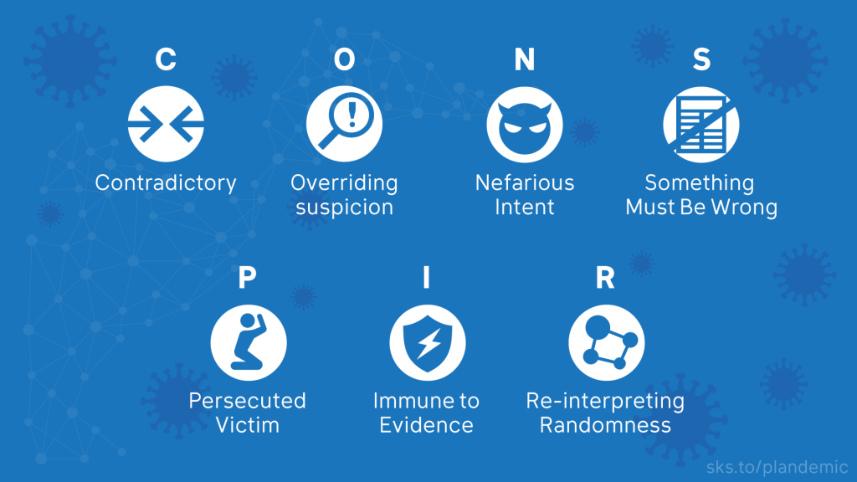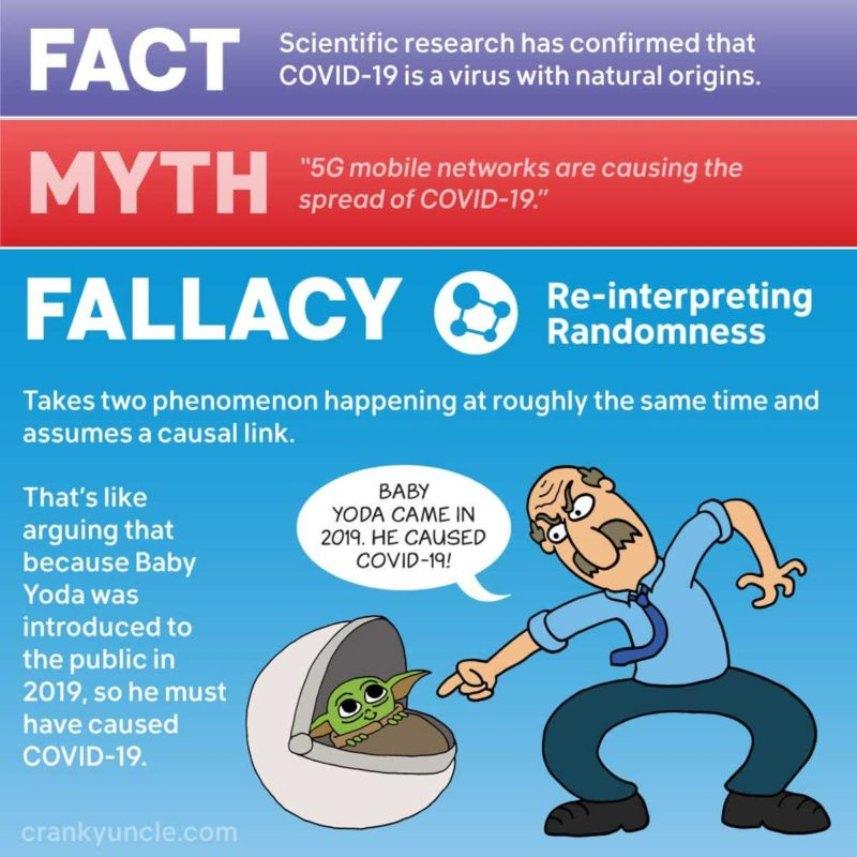Conspiracy Theories
How can you help your students recognize, analyze, and reject the numerous conspiracy theories that have sprung up during the coronavirus pandemic? NCSE Director of Teacher Support Lin Andrews provides one answer: a critical thinking tool called CONSPIR.

The seven traits of conspiratorial thinking. John Cook, CC BY-ND
Check out our entire series explaining the science involved in the coronavirus pandemic. Sign up to receive our coronavirus update each week.
Conspiracy theories are not new. Misinformation and unsubstantiated claims existed long before a young college entrepreneur took a simple messaging board and turned it into a billion-dollar industry, before a tweet was anything more than birdsong, and well before the phrase “tik-tok” was simply part of a child’s nursery rhyme. However, since social media began its infiltration of almost every aspect of human life, exposure to conspiracy theories has vastly increased. Now, add in the fact that millions of Americans are trapped at home due to the COVID-19 pandemic and one can see why COVID-19 related misinformation (error) and disinformation (deliberate falsehoods) continues to thrive during these uncertain times.
So the question becomes: With the sheer volume of information available right now about COVID-19, how can we expect our students to be able to wade through it all intelligently when we, as adults, are also struggling to determine truth from fiction?
Let’s start with the definition of a conspiracy theory. Defining the phrase itself can be tricky as it has morphed more than once over time — not to mention that among its many synonyms “fake news” and “spin” pop up the most as closely related cousins. Once upon a time, conspiracy theories were actually seen as healthy for our society as they often alerted us to certain political agendas (think Watergate). It’s safe to say that the advent of social media changed that reality for good as the majority of so-called conspiracy theories surrounding the current pandemic have thus far contributed zero scientific evidence to go with their claims. From Bill Gates trying to microchip the world via a vaccine to 5G cell towers compromising our immune systems and intensifying the spread of the virus, the disinformation circulating is in no way good for our health as a society.
How do we fight conspiracy theories?
John Cook, a frequent NCSE collaborator who focuses on combating misconceptions, recently co-authored The Conspiracy Theory Handbook. During a recent conversation with Cook, he noted: “While we do not have a vaccine for COVID-19 at this time, we do have a vaccine for misinformation and conspiracy theories — critical thinking."
So how do we guide our students to critically think? Isn’t that the million-dollar question? In the case of conspiracy theories, just remember the acronym CONSPIR.
By analyzing information using these seven traits, students — or any concerned citizen — can easily pick out the red flags of conspiratorial thinking. If you can answer yes to any of the following questions when reading articles about COVID-19, chances are you have stumbled across an unsubstantiated conspiracy theory or intentional disinformation:
- Contradictory: Does one idea of the theory contradict another idea of the same theory?
- Overriding suspicion: Does the theory state that everyone involved in the official account is a part of the cover-up? Note: This would include all scientists everywhere, media, and even comedians that poke fun during late night. (I suppose it would also include me for writing this article in the first place.)
- Nefarious intent: Does the theory imply lives are being taken or money is the primary goal? Conspirators never have ‘benign” motivations, but are out to harm many people and are often considered "evil."
- Something must be wrong: Does the theory have no solid evidence to support it? Does it instead rely on a “gut feeling” something is wrong?
- Persecuted victim: Does the person promoting the theory feel as if the entire world is out to get them? Are they portraying themselves both as a hero and a victim?
- Immune to evidence: Is contradictory evidence viewed as simply a cover-up? That any evidence that counters the theory must be a part of the conspiracy? Note: Dr. Cook calls this tactic self-sealing.
- Re-interpreting randomness: Are random events interpreted as part of a pattern?
The 5G conspiracy theory
Let’s work through an example: 5G cellular networks are responsible for the rapid spread of the virus.
This conspiracy theory rests upon a pre-existing conspiracy theory that 5G (the next wave of cellular connectivity currently being phased in across the country) can suppress the human immune system. Before 5G began its rollout in 2019, similar theories about 4G were also spread that implied that this non-ionizing form of radiation (which is on the low end of the electromagnetic spectrum and is also used in appliances like microwaves), could cause brain tumors, cancer, infertility, and autism. Now, with the spread of COVID-19, anti-5G groups are using a series of random events (re-interpreting randomness) to make a connection between 5G and the spread of the virus. One random fact they are drawing attention to is that Wuhan, China, was a part of a pilot program launching 5G in December 2019. However, a contradictory fact is that Wuhan was just one of several provinces where China was testing out the new networks. Therefore, if 5G really was responsible for the rapid spread of the virus, we should have seen many more COVID-19 “ground zeros” pop up at once in China, which didn’t happen. Another piece of contradictory evidence is that COVID-19 is spreading in countries, like Iran, without 5G.
There are many other elements of the 5G conspiracy theory that can be debunked using the CONSPIR method. Why don’t you see if your students can find — and debunk — one? Or see the graphic below for yet another way to analyze this conspiracy using CONSPIR. Thanks to the cuddly little green alien featured in Dr. Cook’s cartoon, it happens to be one of my favorites!

Image courtesy of John Cook.
My final question
What do we tell our students about why COVID-19 and coronavirus conspiracy theories are so pervasive? A study by van Prooijen and Douglas (2017) summed up the reasons in a way I think even our students can understand:
Conspiracy theories provide people with simplified answers, specifically to questions of how a certain crisis situation emerged, and which societal actors can and cannot be trusted. These answers are highly relevant for how people cope with crisis situations…
...People often experience crisis situations as uncontrollable, and hence, they are a cause of substantial uncertainty and anxiety among citizens. Moreover, it is often easy to connect societal crises to the purposeful misdeeds of hostile groups, making it likely that many citizens consider the possibility of secret conspiracy formation.
It's easier, then, for people to blame some group with nefarious intent (another CONSPIR checkpoint!) when under duress. Additionally, when people feel that they are not in control of a situation or the future is very uncertain, these emotions and worries can be intensified. Viruses can not be controlled, but we can burn down or disable 5G cell towers (approximately 70 such events have occurred at this time all over the world, including the US). Mix in social isolation and you have the perfect cocktail for why so many “likes” and “retweets” lead to increased sharing of disinformation.
If and when a vaccine becomes available to combat COVID-19, a new round of conspiratorial thinking will likely surge. How we help our students break down these false claims will be crucial to everyone’s safety. John Cook stated it best: we have to help students build up “cognitive immunity” against science denial and conspiratorial thinking. We have to educate and continually break down fallacies with scientific evidence. Most importantly, we can not give up hope that reason and logic will prevail. Spread the word: CONSPIR is power.

